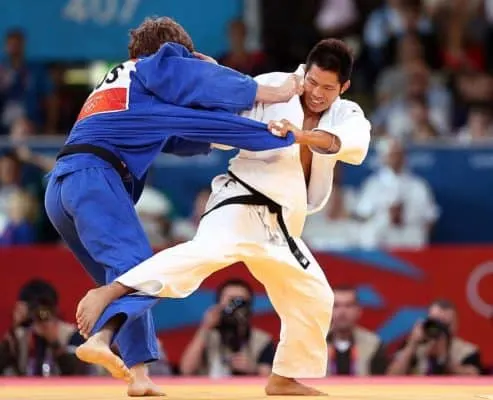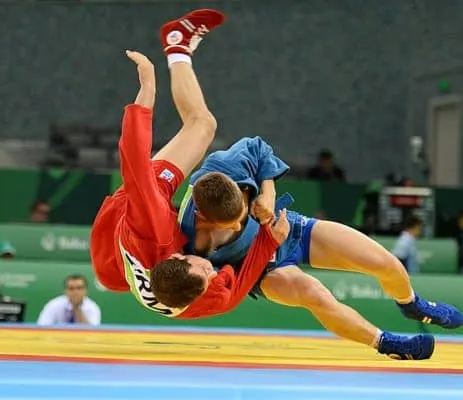
There are many combat-style sports and martial arts that resemble each other and seem to have similar techniques. Sambo and Judo are two styles that often seem similar to each other, but when you take a close look at each fighting style, there are some significant key differences between the two.
The crucial difference between Judo and Sambo is that Judo was designed to be practiced for self-defense, mental and physical benefits, and as a sport for everyone. Conversely, Sambo was designed exclusively for the Russian military to prepare for brutal hand-to-hand combat situations.
When you take a cursory look at Sambo and Judo, they seem to have many similarities, especially with the grappling-type techniques. While this observation is true, and they certainly do have some similarities, there are fundamental differences between Sambo and Judo that distinguish each from the other.
What Are The Fundamentals Of Judo?

Japan has been the birthplace of many martial arts, and this includes Judo. It is considered to be a modern martial art because it is a relatively young fighting style, developed in 1882. This is considered young because many other martial arts can trace their roots back for many centuries in their country of origin.
The creator of Judo was a Japanese educator and athlete by the name of Jigoro Kano, and he based his development of Judo on Japanese Jiu-jitsu(Also known as Jujutsu).
The fundamentals of Judo include the following aspects of martial art.
- The takedown. One of the main objectives in Judo is to throw or takedown an opponent onto the mat or the ground.
- Subdue an opponent. Subduing an opponent by immobilizing them with a prescribed pin technique.
- Force a submission. A submission can be forced in Judo by executing a choke or a joint lock which results in the opponent submitting.
- Strikes. Judo does include training for strikes with both the feet and the hands, but only in the form of pre-arranged kata. They are not allowed during Judo competitions or during free practice sessions. Strikes are not taught as a means of attack or to subdue the opponent but are used to teach a student how to deal with a strike.
- Weapons. Judo includes training with weapons, but the weapons are used to teach Judoka or practitioners how to defend against a weapon. They are never taught as a means for attack.
Judo rules do not allow the attacking of any joint of the body other than the elbow. It is illegal to touch the face of an opponent when you are training or engaged in a Judo match.
Recent changes to Judo have made leg takedowns and leg attacks illegal moves in the sport; however, if you train traditional or old school Judo, you will still be taught these techniques.
What Are The Fundamentals Of Sambo?

If Judo is considered a modern fighting style because of its recent origins, Sambo is an even younger fighting style. Sambo is a combat-fighting style that originates from Russia and was developed in the 1920s.
Sambo was originally developed for the Soviet military as a means of unarmed combat and had its foundation in many different martial arts, including Judo, Jui-Jitsu, boxing, Greco-roman wrestling, and other martial arts.
The intention around the development was not as a sport but as a form of unarmed combat for soldiers. The military form of Sambo is referred to as Combat Sambo, and the sport version of the fighting style is referred to as Sport Sambo.
Sport Sambo’s techniques and moves are akin to judo and wrestling without striking techniques. In contrast, Combat Sambo involves many more forms of attacks and strikes, including head strikes, which are more appropriate for a soldier in a life-and-death situation than a sport.
The fundamentals of Combat Sambo include the following techniques and philosophies.
- Win at all costs. Combat Sambo’s philosophy is to win at all costs because if you lose, it could cost you your life.
- Strikes. Combat Sambo actively uses strikes, including using the head as a weapon, elbows, and hands.
- A wider range of grappling techniques. A wider range of grappling techniques are used in Combat Sambo, including takedowns by the legs.
- Weapons as a form of attack. Combat Sambo includes teaching how to use various weapons as a tool to attack the opponent.
Sport Sambo bears a closer resemblance to Judo and includes the following.
- Grappling. Sport Sambo includes many grappling techniques that were incorporated into the style from wrestling.
- Takedowns. Takedowns are taught using a combination of techniques from Wrestling and Judo.
- Leglocks. Leglocks are used both as a form of takedown and to generate a submission.
- Submission holds. Submission holds, and joint locks are taught targeting joins of the arms and the legs.
- Strikes. Strikes are not allowed in Sport Sambo.
Sport Sambo more closely resembles Judo because it is basically Combat Sambo that has been toned down to be a sporting activity rather than a life and death fight.
The Key Difference Between Judo And Sambo
Even though Sambo and Judo have a lot of similarities, there are some key differences between the two combat styles, mostly because of Sambo’s adoption of techniques from other fighting styles.
The main differences between Sambo and Judo that differentiate the two fighting styles are as follows.
- Judo allows for chokeholds, but this is an illegal move in Sambo.
- Modern Judo does not allow for leg takedowns or leg attacks. These moves are sanctioned in Sambo.
- Judo teaches the philosophy of peace and has a spiritual and morality component that is taught as part of the fighting art. This is not the case in Sambo; it is strictly a fighting sport.
- Sambo was created for the military, while Judo was created as a sport.
- Up until 2020, Sambo did not have a belt grading system. Judo has had a belt grading system since its inception.
- Judo is an Olympic sport but Sambo is not yet accepted as an official Olympic sport.
Is Judo Or Sambo More Effective In Self Defense?
Judo is a fighting style that is oriented around defense, while Sambo promotes attack. Even though there are differences between the moves and philosophies of these two fighting styles, they are both very effective styles for self-defense.
Sambo would be the more effective fighting style for self-defense over Judo because it incorporates a wider range of grappling and takedown techniques that are not taught when learning Judo. This is not to say that Judo is ineffective for self-defense, just that Sambo is a more robust system that better prepares you in self-defense situations.
If you are competent in Judo, it will most certainly be to your advantage when you need to defend yourself. Most attackers would be unfamiliar with Judo and would be surprised by the Judo techniques that are used against them.
Judo teaches you to put your opponent down, and once your attacker is down, you can make your escape to safety.
Sambo has many more moves and techniques that are taught as part of the style, including takedowns using your legs and targeting the legs of your attacker. This would give you a greater number of options when called upon to use your skills for self-defense.
Both Judo and Sambo are effective as self-defense fighting skills, and the techniques learned in both fighting styles will serve you well if you need to use them to defend yourself.
Which One Should I Choose Judo Or Sambo?
The decision regarding which fighting style you should choose to learn will depend on several factors. The first being personal preference.
If you like the history and the whole being aspect of Judo which includes training body, mind, and spirit, then Judo would be the more appropriate style to chose.
If you are only interested in learning self-defense skills, then Sambo would be the better of the styles to choose to learn.
Another influencing factor may be availability. There are many more training facilities offering lessons in Judo than there are offering training in Sambo.
If Sambo is not offered in your location, start off with Judo. The skills you learn in Judo are useful and have relevance should the opportunity to learn Sambo should present itself for you in the future.
Conclusion
Even though Sambo and Judo have many points of similarity, the key differences in the philosophy and techniques between the two styles make them unique and separate from each other.
Both styles are great to learn from a self-defense point of view, but if you are looking to get into MMA, Sambo would be the better style to focus your attention on.
